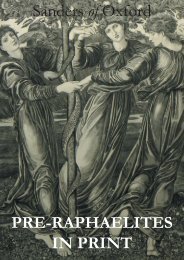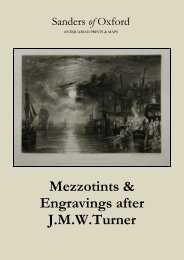«Heading» - International League of Antiquarian Booksellers
«Heading» - International League of Antiquarian Booksellers
«Heading» - International League of Antiquarian Booksellers
You also want an ePaper? Increase the reach of your titles
YUMPU automatically turns print PDFs into web optimized ePapers that Google loves.
The story <strong>of</strong> Alexander the Great and his doctor, Philip,<br />
is told by many ancient authors including Plutarch in his<br />
'Parallel Lives'. Plutarch relates how, after Alexander<br />
fell ill, one <strong>of</strong> his generals wrote him a letter warning<br />
that Philip, Alexander's doctor and old friend, had been<br />
corrupted by the Persian enemy. Alexander nevertheless<br />
trusted Philip and fearlessly drank the medicine which<br />
the latter had prepared. This print shows Alexander<br />
drinking as Philip reads the accusatory letter.<br />
throughout, the vessel also boasted numerous technical<br />
innovations which would become more standardised in<br />
the twentieth-century. Apart from an engraving <strong>of</strong> the<br />
Ross Winans’ cradle launching held by the National<br />
Maritime Museum, no other images <strong>of</strong> the ship are<br />
known, making this lithograph incredibly rare.<br />
Johann Peter Pichler (1765 - 1807) was an Austrian<br />
mezzotinter, trained from 1783 under Jacobe in Vienna<br />
Academy. He spent 1796-7 in Dessau, returning to<br />
Vienna 1797 as Jacobe's successor (and whose daughter<br />
he married). Some <strong>of</strong> his prints were published by the<br />
Chalcographische Gesellschaft.<br />
Heinrich Friedrich Füger (1751 – 1818 ) was a German<br />
portrait and historical painter. He was a pupil <strong>of</strong> Guibal<br />
in Stuttgart and <strong>of</strong> Oeser in Leipzig. Afterward he<br />
traveled and spent some time in Rome and Naples,<br />
where he painted frescoes in the Palazzo Caserta. On his<br />
return to Vienna he was appointed court painter,<br />
pr<strong>of</strong>essor and vice director <strong>of</strong> the Academy, and in 1806<br />
director <strong>of</strong> the Belvedere Gallery.<br />
Pichler 21, Le Blanc 37 i/ii, Lennox-Boyd ii/ii<br />
Ex.Col.: Hon. Christopher Lennox-Boyd<br />
Condition: Repaired tear to upper-middle section <strong>of</strong> the<br />
image.<br />
[27306]<br />
£300<br />
Condition: Trimmed just inside <strong>of</strong> plate to the lower<br />
margin, repaired tears to the upper & left margins just<br />
affecting image. Some minor creases to the top <strong>of</strong> sheet.<br />
Repaired loss to top right hand corner <strong>of</strong> margin not<br />
affecting image. Crease to top right hand corner. Some<br />
scratches to the top <strong>of</strong> sheet.<br />
[27761]<br />
£600<br />
Maritime<br />
123. The Steam-Yacht “Ross Winans” (Cigar Ship)<br />
Lithograph<br />
Anonymous<br />
c. 1866<br />
Image 248 x 353 mm, Sheet 327 x 440 mm<br />
unmounted<br />
The concept <strong>of</strong> the ‘cigar ship,’ one <strong>of</strong> the nineteenthcentury’s<br />
most bizarre examples <strong>of</strong> naval engineering,<br />
was invented by the Winan brothers. Wealthy and<br />
successful railway engineers, the Winans brothers<br />
rejected the prevailing view that steam propulsion was<br />
merely a useful adjunct to sail whilst the theory <strong>of</strong> their<br />
so called ‘cigar ships’ was to discard all masts, sails and<br />
rigging. There were four <strong>of</strong> these ships in total; the first<br />
was launched in Baltimore in 1858, the second and<br />
third, St. Petersburg and Le Havre, respectively. This<br />
print depicts the fourth and largest <strong>of</strong> the ships, built at<br />
Hepsworth’s Yard on the Isle <strong>of</strong> Dogs, and launched in<br />
1866. Classed as a yacht and named the Ross Winans,<br />
the ship was 256 feet long and powered by propellers at<br />
both bow and stern. Lavishly furnished and appointed<br />
124. Clipper Ship Red Jacket, Captain Reed, <strong>of</strong> the<br />
White Star Line <strong>of</strong> Australian Packets among Lice on<br />
her passage from Melbourne to Liverpool in Lat 53’,<br />
47 S Long 47’, 43’. 27 August 1854.<br />
Lithograph with hand colouring<br />
John R. Isaac<br />
Drawn on Stone by John R.Isaac 62 ,Castle Street c<br />
1855<br />
Image 400 x 515 mm<br />
mounted<br />
Red Jacket' was a famous clipper ship, one <strong>of</strong> the largest<br />
and fastest ever built. She was named after<br />
Sagoyewatha, a famous Seneca Indian chief, called<br />
"Red Jacket" by settlers. She was designed by Samuel<br />
Hartt Pook, built by George Thomas in Rockland,<br />
Maine, and launched in 1853.<br />
[23799]<br />
£850












